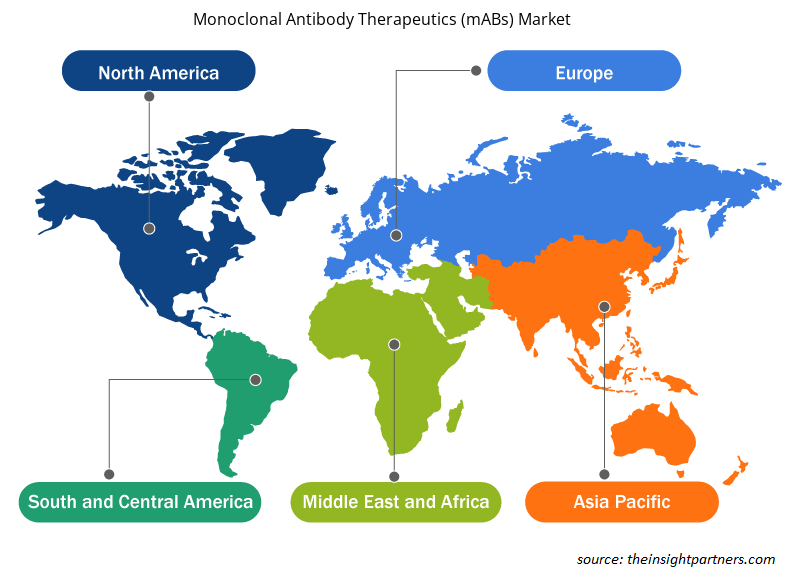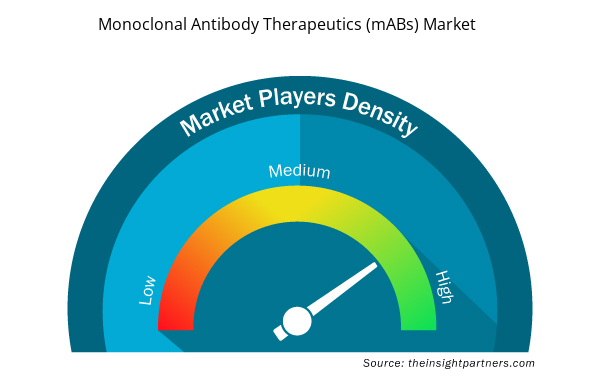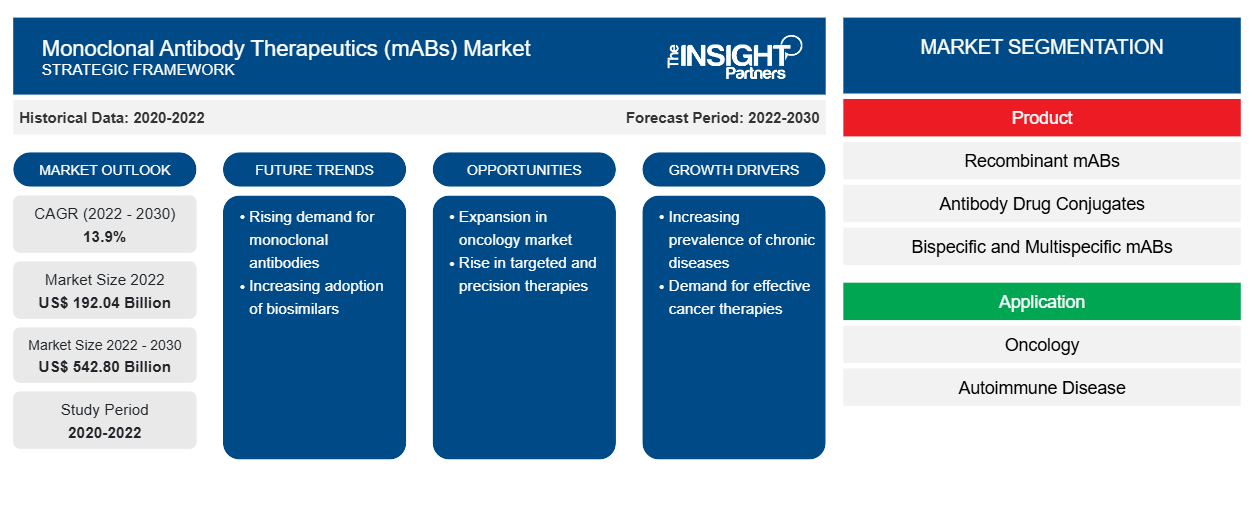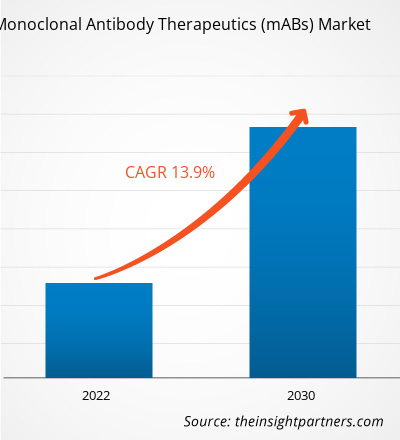[Forschungsbericht] Der Markt für monoklonale Antikörpertherapeutika (mABs) soll von 192,04 Milliarden US-Dollar im Jahr 2022 auf 542,80 Milliarden US-Dollar im Jahr 2030 wachsen; für den Zeitraum 2022–2030 wird für den Markt eine durchschnittliche jährliche Wachstumsrate (CAGR) von 13,9 % geschätzt.
Markteinblicke und Analystenansichten:
Intensive Forschung und Entwicklung sowie die zunehmende Verbreitung chronischer Krankheiten dürften in den nächsten Jahren einen erheblichen Einfluss auf die Marktprognose für monoklonale Antikörpertherapeutika (mABs) haben.
Ein monoklonaler Antikörper (mAbs) ist eine homogene Sammlung von Antikörpern, die spezifisch auf ausgewählte Zielantigene wirken. Der Produktionsprozess von therapeutischen mAbs erfordert ein Säugetier-Expressionssystem, das die Zellmaschinerie bietet, die für die Glykosylierung, Faltung, Ausrichtung und kovalente Bindung von Antikörperpeptidketten zur Herstellung vollständiger und biologisch funktionsfähiger Moleküle unerlässlich ist. Antikörper neuer Modalitäten wie bispezifische und trispezifische Antikörper erkennen mehrere Epitope auf einem einzelnen Antigen, während Einzeldomänenantikörper leichter in Gewebe eindringen können. Solche fortschrittlichen Antikörpertypen können die Effizienz der Antikörpertherapeutika steigern und so ihre Anwendungsbereiche erweitern. Diese Antikörper können auch Antikörper-Wirkstoff-Konjugate bilden , um die Effizienz von Chemotherapeutika beim Angreifen bestimmter Zelltypen zu verbessern. Die Produktion von mAB-basierten Medikamenten zur Behandlung verschiedener Krankheiten treibt die Marktentwicklung voran. Innovative Produkteinführungen durch strategische Entwicklungen der Hersteller bieten lukrative Marktchancen. Darüber hinaus stellen Kombinationsmedikamente mit mABs einen Markttrend für den Markt für mAbs-Therapeutika dar.
Markttreiber
Produktion mAB-basierter Medikamente zur Behandlung verschiedener Krankheiten treibt Marktwachstum an
Monoklonale Antikörpertherapeutika (mABs) werden zur Behandlung einer Vielzahl von Krankheiten eingesetzt, darunter Krebs, Autoimmunerkrankungen und Stoffwechselerkrankungen . Solche von biopharmazeutischen Unternehmen und wissenschaftlichen Forschungsinstituten hergestellten Medikamente haben aufgrund ihrer hohen Spezifität, starken Zielgenauigkeit und geringen Toxizität und Nebenwirkungen auf dem Weltmarkt große Aufmerksamkeit erlangt. Daher wird erwartet, dass eine Steigerung der Produktionskapazitäten für mAB-Therapeutika das Marktwachstum für monoklonale Antikörpertherapeutika (mABs) vorantreiben wird.
Therapeutische mABs in der Europäischen Union (EU) und den USA zugelassen
Produkte | Markenname | Krankheitsindikation | Zulassungsjahr: EU | Zulassungsjahr: USA |
Pozelimab | VEOPOZ | CHAPLE-Krankheit | N / A | 2023 |
Elranatamab | Abonnieren | Multiples Myelom | 2023 | 2023 |
Rozanolixizumab | RYSTIGGO | Generalisierte Myasthenia gravis | 2024 | 2023 |
Talquetamab | TALVEY | Multiples Myelom | 2023 | 2023 |
Epcoritamab | EPKINLY | Diffuses großzelliges B-Zell-Lymphom | 2023 | 2023 |
Mirikizumab | Ohhh | Colitis ulcerosa | 2023 | 2023 |
Quelle: Antibody Society
Marktchance
Innovative Produkteinführungen durch strategische Entwicklungen der Hersteller
Organische Entwicklungen wie Produkteinführungen von Herstellern therapeutischer mABs dürften den Markt für monoklonale Antikörpertherapeutika (mABs) in den kommenden Jahren stärken. Im März 2022 kündigte Adagio Therapeutics, Inc. die Markteinführung von ADG20 (ADINTREVIMAB) an. Das neu eingeführte Produkt ist der erste monoklonale Antikörper, der primäre Endpunkte mit statistischer Signifikanz bei der Prä- und Postexpositionsprophylaxe und -behandlung von COVID-19 erreicht, indem es eine US-Notfallzulassung (EUA) beantragt.
Darüber hinaus würden anorganische Entwicklungen wie Fusionen und Übernahmen zur Einführung neuer therapeutischer mABs führen. So kündigte Elli Lilly im Juli 2023 die Übernahme von Versanis an, einem privaten biopharmazeutischen Unternehmen in der klinischen Phase, das kardiometabolische Erkrankungen behandeln soll. Elli Lilly erwarb Versanis, um auf sein Kernproduktportfolio zuzugreifen, darunter ein monoklonales Antikörperprodukt namens Bimagrumab. Dieses Produkt wird derzeit in der „BELIEVE Phase 2b-Studie“ als eigenständiges Molekül untersucht. Es wird auch in Kombination mit Semaglutid auf sein kombiniertes Potenzial untersucht, die Fettmasse zu reduzieren, die Muskelmasse zu erhalten und bessere Patientenergebnisse bei Menschen mit Fettleibigkeit und fettleibigkeitsbedingten Komplikationen zu erzielen. Die oben genannten Faktoren sind für das einflussreiche Marktwachstum bei monoklonalen Antikörpertherapeutika (mABs) in den kommenden Jahren verantwortlich.
Markttrends für monoklonale Antikörpertherapeutika (mABs)
Kombinationspräparate mit monoklonalen Antikörpern (mABs)
Laut dem Bericht 2021 des National Institute of Health (NIH) haben die Pharmaunternehmen Roche und Regeneron die klinische Testphase 2/3 eingeleitet, um kombinierte monoklonale Antikörper für Patienten mit leichtem bis mittelschwerem COVID-19 zu untersuchen. Sie untersuchen „REGN-COV2“, ein Cocktail-Medikament, das durch die Kombination zweier monoklonaler Antikörper – Casirivimab und Imdevimab – zur Behandlung von COVID-19 hergestellt wird. Diese Unternehmen erwarten, dass die Kombination dieses mAB-Medikaments die Krankenhausaufenthalte um 70 % reduzieren würde und bei Kindern über 12 Jahren (mit einem Körpergewicht von mehr als 40 kg) wirksamer wäre. Forscher suchen dringend nach weiteren solchen therapeutischen Kombinationen monoklonaler Antikörper. Beispielsweise haben die von Elli Lilly entwickelten Medikamente Bamlanivimab und Etesivimab im Jahr 2022 positive klinische Ergebnisse bei COVID-19 gezeigt. Daher werden Kombinationspräparate aus monoklonalen Antikörpern zur Behandlung mehrerer Krankheiten in den kommenden Jahren erhebliche Aufmerksamkeit erlangen und sich so zu einem wichtigen Trend auf dem Markt für monoklonale Antikörpertherapeutika (mABs) entwickeln.
Passen Sie diesen Bericht Ihren Anforderungen an
Sie erhalten kostenlos individuelle Anpassungen an jedem Bericht, einschließlich Teilen dieses Berichts oder einer Analyse auf Länderebene, eines Excel-Datenpakets sowie tolle Angebote und Rabatte für Start-ups und Universitäten.
- Holen Sie sich die wichtigsten Markttrends aus diesem Bericht.Dieses KOSTENLOSE Beispiel umfasst eine Datenanalyse von Markttrends bis hin zu Schätzungen und Prognosen.
Berichtssegmentierung und -umfang:
Die Marktanalyse für monoklonale Antikörpertherapeutika (mABs) wurde unter Berücksichtigung der folgenden Segmente durchgeführt: Produkt, Anwendung und Vertriebskanal
Der Markt ist nach Produkten unterteilt in rekombinante mABs, Antikörper-Wirkstoff-Konjugate, bispezifische und multispezifische mABs, Biosimilars und Sonstiges. Der Markt für monoklonale Antikörpertherapeutika (mABs) ist nach Anwendung in Onkologie, Autoimmunerkrankungen und Sonstiges unterteilt. Der Markt für Autoimmunerkrankungen ist weiter unterteilt in rheumatoide Arthritis, Psoriasis, Colitis ulcerosa und Sonstiges. Der Markt für monoklonale Antikörpertherapeutika (mABs) ist nach Vertriebskanälen unterteilt in Krankenhausapotheken, Einzelhandelsapotheken und Sonstiges.
In Bezug auf das Produkt hielt das Segment der rekombinanten mABs im Jahr 2022 den größten Marktanteil bei monoklonalen Antikörpertherapeutika (mABs). Das Segment der Antikörper-Wirkstoff-Konjugate wird im Prognosezeitraum voraussichtlich die schnellste CAGR von 18,5 % verzeichnen. Laut dem Bericht von ACS Publications spiegeln therapeutische rekombinante monoklonale Antikörper den neuesten Stand der biomedizinischen Forschung wider, die durch die Planung wirksamer Strategien zur Behandlung einer breiten Palette von Krankheiten durchgeführt wird, für die keine wirksame Behandlung verfügbar ist. Tocilizumab ist ein Beispiel für ein rekombinantes mAB-Medikament, das zur Behandlung von Arthritis, idiopathischer Arthritis und rheumatoider Arthritis (RA) verabreicht wird. Darüber hinaus können rekombinante mABs auch zur Behandlung von Krankheiten wie Autoimmunerkrankungen und Krebs eingesetzt werden. Bevacizumab ist ein Beispiel für ein rekombinantes mAB, das derzeit zur Behandlung von Brust-, Lungen- und Dickdarmkrebs, HIV-1, bakteriellen Toxininfektionen/-reaktionen sowie SARS-CoV-2- und Ebolavirusinfektionen eingesetzt wird.
Antikörper-Wirkstoff-Konjugate (ADC) sind eine sich rasch entwickelnde Klasse von Therapeutika und eine neue Klasse hochwirksamer Arzneimittel, die eine Kombination aus Chemotherapie und Immuntherapie nutzen. Laut einem Bericht des NIH basieren ADCs derzeit überwiegend auf Immunglobulin G (IgG), und bisher wurden 13 ADCs von der US-amerikanischen Food and Drug Administration (FDA) zugelassen. Darüber hinaus befinden sich mehr als 90 ADCs in der klinischen Entwicklung/Erprobung.
Sr. Nr. | Produkt (Zugelassene ADCs) | Krankheitsindikation |
1 | Mylotarg | Rezidivierende akute myeloische Leukämie |
2 | Adcetris | Rezidivierendes Hodgkin-Lymphom und rezidivierende systemische anaplastische großzellige Lymphome |
3 | Kadyla | HER2-positiver metastasierter Brustkrebs |
4 | Besponsa | Rezidivierende oder refraktäre CD22-positive B-Zell-Vorläufer-akute lymphatische Leukämie |
5 | Lumoxiti | Rezidivierende oder refraktäre Haarzellenleukämie oder HCL |
6 | Politik | Rezidiviertes oder refraktäres (R/R) diffuses großzelliges B-Zell-Lymphom oder DLBCL |
7 | Padcev | Metastasierter Urothelkrebs |
8 | Enhertu | Metastasierter HER2-positiver Brustkrebs |
9 | Trodelvy | Metastasierter dreifach negativer Brustkrebs |
10 | Blenrep | Rezidiviertes oder refraktäres multiples Myelommyeloma |
11 | Zynlota | Großzelliges B-Zell-Lymphom |
12 | Tivdak | Therapie bei rezidivierendem oder metastasiertem Gebärmutterhalskrebs |
13 | Elahere | Platinresistenter Eierstockkrebs |
Quelle: Support-Artikel zur Einmalverwendung
Daher fördern behördliche Zulassungen von ADCs und laufende klinische Studien für Behandlungsansätze für seltene Krankheiten das Wachstum des Marktes für monoklonale Antikörpertherapeutika (mABs) im Segment der Antikörper-Wirkstoff-Konjugate im Prognosezeitraum.
Regionale Analyse:
Geografisch deckt der Marktbericht für monoklonale Antikörpertherapeutika (mABs) Nordamerika, Europa, den asiatisch-pazifischen Raum, den Nahen Osten und Afrika sowie Süd- und Mittelamerika ab. Im Jahr 2022 hatte Nordamerika den größten globalen Marktanteil an monoklonalen Antikörpertherapeutika (mABs). Der asiatisch-pazifische Raum dürfte zwischen 2022 und 2030 die höchste CAGR verzeichnen. In Nordamerika haben die USA den größten Marktanteil. Beschleunigte Produktzulassungsverfahren für mABs-Therapeutika kommen dem Markt in diesem Land zugute. Bis Dezember 2019 wurden laut Statistiken einer im Fachjournal BioMed Central veröffentlichten Studie 79 therapeutische mABs von der US-amerikanischen FDA zugelassen. Von den 79 therapeutischen mABs sind 30 für die Krebsbehandlung vorgesehen. Im Mai 2021 gab die FDA eine genehmigte EUA für die Verwendung eines neuen therapeutischen mABs – Sotrovimab – bekannt, das für ambulante Anwendungen zur Behandlung von Menschen mit schwerer COVID-19-Erkrankung vorgesehen ist. Im Februar 2022 gab die FDA die Erteilung einer EUA für Bebtelovimab von Elli Lilly and Company bekannt, ein Beispiel für einen mAB, der gegen die Omikron-Variante eingesetzt werden soll. Darüber hinaus ist Etesevimab auch ein Beispiel für einen von der US-amerikanischen FDA zugelassenen therapeutischen mAB.
Regionale Einblicke in den Markt für monoklonale Antikörpertherapeutika (mABs)
Die regionalen Trends und Faktoren, die den Markt für monoklonale Antikörpertherapeutika (mABs) während des gesamten Prognosezeitraums beeinflussen, wurden von den Analysten von Insight Partners ausführlich erläutert. In diesem Abschnitt werden auch die Marktsegmente und die Geografie für monoklonale Antikörpertherapeutika (mABs) in Nordamerika, Europa, im asiatisch-pazifischen Raum, im Nahen Osten und Afrika sowie in Süd- und Mittelamerika erörtert.

- Erhalten Sie regionale Daten zum Markt für monoklonale Antikörpertherapeutika (mABs)
Umfang des Marktberichts über monoklonale Antikörpertherapeutika (mABs)
| Berichtsattribut | Details |
|---|---|
| Marktgröße im Jahr 2022 | 192,04 Milliarden US-Dollar |
| Marktgröße bis 2030 | 542,80 Milliarden US-Dollar |
| Globale CAGR (2022 - 2030) | 13,9 % |
| Historische Daten | 2020-2022 |
| Prognosezeitraum | 2022–2030 |
| Abgedeckte Segmente | Nach Produkt
|
| Abgedeckte Regionen und Länder | Nordamerika
|
| Marktführer und wichtige Unternehmensprofile |
|
Marktteilnehmerdichte: Der Einfluss auf die Geschäftsdynamik
Der Markt für monoklonale Antikörpertherapeutika (mABs) wächst rasant, angetrieben durch die steigende Endverbrauchernachfrage aufgrund von Faktoren wie sich entwickelnden Verbraucherpräferenzen, technologischen Fortschritten und einem größeren Bewusstsein für die Vorteile des Produkts. Mit steigender Nachfrage erweitern Unternehmen ihr Angebot, entwickeln Innovationen, um die Bedürfnisse der Verbraucher zu erfüllen, und nutzen neue Trends, was das Marktwachstum weiter ankurbelt.
Die Marktteilnehmerdichte bezieht sich auf die Verteilung von Firmen oder Unternehmen, die in einem bestimmten Markt oder einer bestimmten Branche tätig sind. Sie gibt an, wie viele Wettbewerber (Marktteilnehmer) in einem bestimmten Marktraum im Verhältnis zu seiner Größe oder seinem gesamten Marktwert präsent sind.
Die wichtigsten Unternehmen auf dem Markt für monoklonale Antikörpertherapeutika (mABs) sind:
- GlaxoSmithKline
- F.Hoffmann-La-Roche
- Bayer AG
- Amgen
- Novartis
Haftungsausschluss : Die oben aufgeführten Unternehmen sind nicht in einer bestimmten Reihenfolge aufgeführt.

- Überblick über die wichtigsten Akteure auf dem Markt für monoklonale Antikörpertherapeutika (mABs)
Entwicklungen und zukünftige Chancen in der Branche der monoklonalen Antikörpertherapeutika (mABs):
Nachfolgend sind verschiedene strategische Entwicklungen führender Akteure auf dem Markt für monoklonale Antikörpertherapeutika (mABs) aufgeführt:
- Im Januar 2023 erhielt AstraZeneca die Zulassung für Evusheld in der Europäischen Union (EU). Evusheld ist eine Kombination aus zwei langwirksamen Antikörpern – Tixagevimab (AZD8895) und Cilgavimab (AZD1061). Die US-Regierung unterstützte die Entwicklung dieses Produkts durch Bundesmittel des Gesundheitsministeriums, der Administration for Strategic Preparedness and Response und der Biomedical Advanced Research and Development Authority.
- Im August 2023 schloss Regeneron Pharmaceuticals, Inc. eine Vereinbarung mit der Biomedical Advanced Research and Development Authority (BARDA) ab, um die klinische Entwicklung, die klinische Herstellung und den Zulassungsprozess für die monoklonale Antikörpertherapie der nächsten Generation gegen COVID-19 zu unterstützen. Im Rahmen dieser Vereinbarung plant Regeneron, mit BARDA zusammenzuarbeiten, um diese Therapie zu evaluieren, weiterzuentwickeln und herzustellen sowie regulatorische Aktivitäten durchzuführen.
Wettbewerbslandschaft und Schlüsselunternehmen:
GlaxoSmithKline, F.Hoffmann-La-Roche, Bayer AG, Amgen, Novartis, AbbVie, Bristol-Myers Squibb, Janssen Pharmaceutical, Merck KgaA und AstraZeneca gehören zu den führenden Unternehmen auf dem Markt für monoklonale Antikörpertherapeutika (mABs). Der Marktbericht für monoklonale Antikörpertherapeutika (mABs) umfasst die Positionierung und Konzentration der Unternehmen, um die Leistung der wichtigsten Akteure auf dem Markt zu bewerten.
- Historische Analyse (2 Jahre), Basisjahr, Prognose (7 Jahre) mit CAGR
- PEST- und SWOT-Analyse
- Marktgröße Wert/Volumen – Global, Regional, Land
- Branche und Wettbewerbsumfeld
- Excel-Datensatz



Report Coverage
Revenue forecast, Company Analysis, Industry landscape, Growth factors, and Trends

Segment Covered
This text is related
to segments covered.

Regional Scope
North America, Europe, Asia Pacific, Middle East & Africa, South & Central America

Country Scope
This text is related
to country scope.
Häufig gestellte Fragen
Key factors that are driving the growth of this market are production of mabs-based drugs to treat several infectious diseases is expected to boost the market growth for the monoclonal antibody therapeutics over the years.
The CAGR value of the monoclonal antibody therapeutics market during the forecasted period of 2022-2030 is 13.9%.
The recombinant mABs segment held the largest share of the market in the global monoclonal antibody therapeutics market and held the largest market share in 2022.
Amgen and GlaxoSmithKline are the top two companies that hold huge market shares in the monoclonal antibody therapeutics market.
Monoclonal antibody (mAbs) therapeutics is a homogenous collection of antibodies used to treat illness and are selected to target antigens. Therapeutic mAbs require a mammalian expression system offering the cell machinery required to glycosylate, fold, orient, and covalently bind antibody peptide chains to produce complete and biologically functional molecules. Also, the therapeutic antibody is expanding the use of new modality antibodies such as bispecific and trispecific antibodies to recognize the multiple epitopes on the same antigen and single domain antibodies that can more easily penetrate tissues and antibody-drug conjugates for targeting chemotherapy agents to specific cell types.
The autoimmune disease segment dominated the global monoclonal antibody therapeutics market and held the largest market share in 2022.
The monoclonal antibody therapeutics market majorly consists of the players such GlaxoSmithKline, F.Hoffmann-La-Roche, Bayer AG, Amgen, Novartis, AbbVie, Bristol-Myers Squibb, Janssen Pharmaceutical, Merck KgaA, and AstraZeneca, and amongst others.
Global monoclonal antibody therapeutics market is segmented by region into North America, Europe, Asia Pacific, Middle East & Africa and South & Central America. North America held the largest market share of the monoclonal antibody therapeutics market in 2022.
Trends and growth analysis reports related to Life Sciences : READ MORE..
The List of Companies - Monoclonal Antibody Therapeutics (mABs) Market
- GlaxoSmithKline
- F.Hoffmann-La-Roche
- Bayer AG
- Amgen
- Novartis
- AbbVie
- Bristol-Myers Squibb
- Janssen Pharmaceutical
- Merck KgaA
- AstraZeneca
The Insight Partners performs research in 4 major stages: Data Collection & Secondary Research, Primary Research, Data Analysis and Data Triangulation & Final Review.
- Data Collection and Secondary Research:
As a market research and consulting firm operating from a decade, we have published and advised several client across the globe. First step for any study will start with an assessment of currently available data and insights from existing reports. Further, historical and current market information is collected from Investor Presentations, Annual Reports, SEC Filings, etc., and other information related to company’s performance and market positioning are gathered from Paid Databases (Factiva, Hoovers, and Reuters) and various other publications available in public domain.
Several associations trade associates, technical forums, institutes, societies and organization are accessed to gain technical as well as market related insights through their publications such as research papers, blogs and press releases related to the studies are referred to get cues about the market. Further, white papers, journals, magazines, and other news articles published in last 3 years are scrutinized and analyzed to understand the current market trends.
- Primary Research:
The primarily interview analysis comprise of data obtained from industry participants interview and answers to survey questions gathered by in-house primary team.
For primary research, interviews are conducted with industry experts/CEOs/Marketing Managers/VPs/Subject Matter Experts from both demand and supply side to get a 360-degree view of the market. The primary team conducts several interviews based on the complexity of the markets to understand the various market trends and dynamics which makes research more credible and precise.
A typical research interview fulfils the following functions:
- Provides first-hand information on the market size, market trends, growth trends, competitive landscape, and outlook
- Validates and strengthens in-house secondary research findings
- Develops the analysis team’s expertise and market understanding
Primary research involves email interactions and telephone interviews for each market, category, segment, and sub-segment across geographies. The participants who typically take part in such a process include, but are not limited to:
- Industry participants: VPs, business development managers, market intelligence managers and national sales managers
- Outside experts: Valuation experts, research analysts and key opinion leaders specializing in the electronics and semiconductor industry.
Below is the breakup of our primary respondents by company, designation, and region:

Once we receive the confirmation from primary research sources or primary respondents, we finalize the base year market estimation and forecast the data as per the macroeconomic and microeconomic factors assessed during data collection.
- Data Analysis:
Once data is validated through both secondary as well as primary respondents, we finalize the market estimations by hypothesis formulation and factor analysis at regional and country level.
- Macro-Economic Factor Analysis:
We analyse macroeconomic indicators such the gross domestic product (GDP), increase in the demand for goods and services across industries, technological advancement, regional economic growth, governmental policies, the influence of COVID-19, PEST analysis, and other aspects. This analysis aids in setting benchmarks for various nations/regions and approximating market splits. Additionally, the general trend of the aforementioned components aid in determining the market's development possibilities.
- Country Level Data:
Various factors that are especially aligned to the country are taken into account to determine the market size for a certain area and country, including the presence of vendors, such as headquarters and offices, the country's GDP, demand patterns, and industry growth. To comprehend the market dynamics for the nation, a number of growth variables, inhibitors, application areas, and current market trends are researched. The aforementioned elements aid in determining the country's overall market's growth potential.
- Company Profile:
The “Table of Contents” is formulated by listing and analyzing more than 25 - 30 companies operating in the market ecosystem across geographies. However, we profile only 10 companies as a standard practice in our syndicate reports. These 10 companies comprise leading, emerging, and regional players. Nonetheless, our analysis is not restricted to the 10 listed companies, we also analyze other companies present in the market to develop a holistic view and understand the prevailing trends. The “Company Profiles” section in the report covers key facts, business description, products & services, financial information, SWOT analysis, and key developments. The financial information presented is extracted from the annual reports and official documents of the publicly listed companies. Upon collecting the information for the sections of respective companies, we verify them via various primary sources and then compile the data in respective company profiles. The company level information helps us in deriving the base number as well as in forecasting the market size.
- Developing Base Number:
Aggregation of sales statistics (2020-2022) and macro-economic factor, and other secondary and primary research insights are utilized to arrive at base number and related market shares for 2022. The data gaps are identified in this step and relevant market data is analyzed, collected from paid primary interviews or databases. On finalizing the base year market size, forecasts are developed on the basis of macro-economic, industry and market growth factors and company level analysis.
- Data Triangulation and Final Review:
The market findings and base year market size calculations are validated from supply as well as demand side. Demand side validations are based on macro-economic factor analysis and benchmarks for respective regions and countries. In case of supply side validations, revenues of major companies are estimated (in case not available) based on industry benchmark, approximate number of employees, product portfolio, and primary interviews revenues are gathered. Further revenue from target product/service segment is assessed to avoid overshooting of market statistics. In case of heavy deviations between supply and demand side values, all thes steps are repeated to achieve synchronization.
We follow an iterative model, wherein we share our research findings with Subject Matter Experts (SME’s) and Key Opinion Leaders (KOLs) until consensus view of the market is not formulated – this model negates any drastic deviation in the opinions of experts. Only validated and universally acceptable research findings are quoted in our reports.
We have important check points that we use to validate our research findings – which we call – data triangulation, where we validate the information, we generate from secondary sources with primary interviews and then we re-validate with our internal data bases and Subject matter experts. This comprehensive model enables us to deliver high quality, reliable data in shortest possible time.


 Holen Sie sich ein kostenloses Muster für diesen Bericht
Holen Sie sich ein kostenloses Muster für diesen Bericht